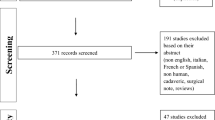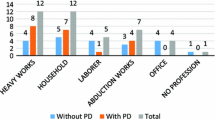Abstract
Purpose
To compare the results two to three years after intervention, using either surgical or non-operative treatment.
Methods
Eighty-seven patients with subacromial impingement syndrome (SAIS) were randomised into open acromioplasty (OS group), arthroscopic acromioplasty (AS group) or physiotherapy (PT group) treatment. The assessments comprised the Constant score, the Watson and Sonnabend score, the SF-36 evaluation and a clinical examination performed by an independent observer. Fifty-five patients attended the clinical follow-up.
Results
The groups were comparable at baseline in terms of demographics and clinical assessments. No significant differences in terms of the clinical assessments or health-related quality of life (QoL) were found between the study groups at follow-up. The Constant score had improved significantly at follow-up in both the OS group and the AS group (p = 0.003 and 0.008, respectively). At follow-up, the OS group revealed improved strength compared with before intervention (p = 0.012). All groups revealed a significantly improved internal rotation (OSG p = 0.01, ASG p = 0.005, PTG p = 0.004). The SF-36 was significantly improved in some scales within all three groups. The Watson and Sonnabend score was significantly improved in 12/14 questions for the OS group, in 5/14 questions for the AS group and in 6/14 for the PT group (p < 0.02 OS group vs. AS group, p < 0.05 OS group vs. PT group).
Conclusion
In this randomised study, the Constant score, other clinical assessments and subjective health-related QoL revealed no significant differences between the 3 groups two to three years after intervention in patients with SAIS. The OS group showed a greater improvement over time.
Level of evidence
CT with low follow-up rate, Level II.

Similar content being viewed by others
References
Angst F, Schwyzer HK, Aeschlimann A, Simmen BR, Goldhahn J (2011) Measures of adult shoulder function: Disabilities of the Arm, Shoulder, and Hand Questionnaire (DASH) and its short version (QuickDASH), Shoulder Pain and Disability Index (SPADI), American Shoulder and Elbow Surgeons (ASES) Society standardized shoulder assessment form, Constant (Murley) Score (CS), Simple Shoulder Test (SST), Oxford Shoulder Score (OSS), Shoulder Disability Questionnaire (SDQ), and Western Ontario Shoulder Instability Index (WOSI). Arthritis Care Res 63(Suppl 11):S174–S188
Biberthaler P, Beirer M, Kirchhoff S, Braunstein V, Wiedemann E, Kirchhoff C (2013) Significant benefit for older patients after arthroscopic subacromial decompression: a long-term follow-up study. Int Orthop 37(3):457–462
Bot SD, van der Waal JM, Terwee CB, van der Windt DA, Schellevis FG, Bouter LM, Dekker J (2005) Incidence and prevalence of complaints of the neck and upper extremity in general practice. Ann Rheum Dis 64(1):118–123
Brox JI, Gjengedal E, Uppheim G, Bohmer AS, Brevik JI, Ljunggren AE, Staff PH (1999) Arthroscopic surgery versus supervised exercises in patients with rotator cuff disease (stage II impingement syndrome): a prospective, randomized, controlled study in 125 patients with a 2 1/2-year follow-up. J Shoulder Elb Surg 8(2):102–111
Böhmer AS (1984) Trening ved kroniske degenerative skulderlidelser. Fysioterapeuten 51:192–197
Chipchase LS, O’Connor DA, Costi JJ, Krishnan J (2000) Shoulder impingement syndrome: preoperative health status. J Shoulder Elb Surg 9(1):12–15
Constant CR, Murley AH (1987) A clinical method of functional assessment of the shoulder. Clin Orthop Relat Res 214:160–164
Davis AD, Kakar S, Moros C, Kaye EK, Schepsis AA, Voloshin I (2010) Arthroscopic versus open acromioplasty: a meta-analysis. Am J Sports Med 38(3):613–618
Dickens VA, Williams JL, Bhamra MS (2005) Role of physiotherapy in the treatment of subacromial impingement syndrome: a prospective study. Physiotherapy 91(3):159–164
Dorrestijn O, Stevens M, Winters JC, van der Meer K, Diercks RL (2009) Conservative or surgical treatment for subacromial impingement syndrome? A systematic review. J Shoulder Elb Surg 18(4):652–660
Ellman H (1987) Arthroscopic subacromial decompression: analysis of one- to three-year results. Arthroscopy 3(3):173–181
Escamilla RF, Hooks TR, Wilk KE (2014) Optimal management of shoulder impingement syndrome. Open Access J Sports Med 5:13–24. doi:10.2147/oajsm.s36646
Faber E, Kuiper JI, Burdorf A, Miedema HS, Verhaar JA (2006) Treatment of impingement syndrome: a systematic review of the effects on functional limitations and return to work. J Occup Rehabil 16(1):7–25
Gajdosik RL, Bohannon RW (1987) Clinical measurement of range of motion. Review of goniometry emphasizing reliability and validity. Phys Ther 67(12):1867–1872
Gebremariam L, Hay EM, Koes BW, Huisstede BM (2011) Effectiveness of surgical and postsurgical interventions for the subacromial impingement syndrome: a systematic review. Arch Phys Med Rehabil 92(11):1900–1913
Haahr JP, Ostergaard S, Dalsgaard J, Norup K, Frost P, Lausen S, Holm EA, Andersen JH (2005) Exercises versus arthroscopic decompression in patients with subacromial impingement: a randomised, controlled study in 90 cases with a one year follow up. Ann Rheum Dis 64(5):760–764
Holmgren T, Bjornsson Hallgren H, Oberg B, Adolfsson L, Johansson K (2012) Effect of specific exercise strategy on need for surgery in patients with subacromial impingement syndrome: randomised controlled study. BMJ 344:e787
Holmgren T, Hallgren HB, Oberg B, Adolfsson L, Johansson K (2013) Republished research: Effect of specific exercise strategy on need for surgery in patients with subacromial impingement syndrome: randomised controlled study. Br J Sports Med 47(14):908
Husby T, Haugstvedt JR, Brandt M, Holm I, Steen H (2003) Open versus arthroscopic subacromial decompression: a prospective, randomized study of 34 patients followed for 8 years. Acta Orthop Scand 74(4):408–414
Jonsson P, Wahlstrom P, Ohberg L, Alfredson H (2006) Eccentric training in chronic painful impingement syndrome of the shoulder: results of a pilot study. Knee Surg Sports Traumatol Arthrosc 14(1):76–81
Kirkley A, Griffin S, Dainty K (2003) Scoring systems for the functional assessment of the shoulder. Arthroscopy 19(10):1109–1120
Klintberg IH, Svantesson U, Karlsson J (2010) Long-term patient satisfaction and functional outcome 8-11 years after subacromial decompression. Knee Surg Sports Traumatol Arthrosc 18(3):394–403
Kuhn JE (2009) Exercise in the treatment of rotator cuff impingement: a systematic review and a synthesized evidence-based rehabilitation protocol. J Shoulder Elb Surg 18(1):138–160
Linsell L, Dawson J, Zondervan K, Rose P, Randall T, Fitzpatrick R, Carr A (2006) Prevalence and incidence of adults consulting for shoulder conditions in UK primary care; patterns of diagnosis and referral. Rheumatology (Oxford, England) 45(2):215–221
Lunsjo K, Bengtsson M, Nordqvist A, Abu-Zidan FM (2011) Patients with shoulder impingement remain satisfied 6 years after arthroscopic subacromial decompression: a prospective study of 46 patients. Acta Orthop 82(6):711–713
Michener LA, Walsworth MK, Burnet EN (2004) Effectiveness of rehabilitation for patients with subacromial impingement syndrome: a systematic review. J Hand Ther 17(2):152–164
Neer CS 2nd (1972) Anterior acromioplasty for the chronic impingement syndrome in the shoulder: a preliminary report. J Bone Joint Surg Am 54(1):41–50
Ostor AJ, Richards CA, Prevost AT, Speed CA, Hazleman BL (2005) Diagnosis and relation to general health of shoulder disorders presenting to primary care. Rheumatology (Oxford, England) 44(6):800–805
Park SI, Choi YK, Lee JH, Kim YM (2013) Effects of shoulder stabilization exercise on pain and functional recovery of shoulder impingement syndrome patients. J Phys Ther Sci 25(11):1359–1362
Rockwood CA, Lyons FR (1993) Shoulder impingement syndrome: diagnosis, radiographic evaluation, and treatment with a modified Neer acromioplasty. J Bone Joint Surg Am 75(3):409–424
Sullivan M, Karlsson J (1998) The Swedish SF-36 Health Survey III. Evaluation of criterion-based validity: results from normative population. J Clin Epidemiol 51(11):1105–1113
Ware JE Jr, Sherbourne CD (1992) The MOS 36-item short-form health survey (SF-36). I. Conceptual framework and item selection. Med Care 30(6):473–483
Watson EM, Sonnabend DH (2002) Outcome of rotator cuff repair. J Shoulder Elb Surg 11(3):201–211
Yian EH, Ramappa AJ, Arneberg O, Gerber C (2005) The constant score in normal shoulders. J Shoulder Elb Surg 14(2):128–133
Yu E, Cil A, Harmsen WS, Schleck C, Sperling JW, Cofield RH (2010) Arthroscopy and the dramatic increase in frequency of anterior acromioplasty from 1980 to 2005: an epidemiologic study. Arthroscopy 26(9 Suppl):S142–S147
Author information
Authors and Affiliations
Corresponding author
Rights and permissions
About this article
Cite this article
Farfaras, S., Sernert, N., Hallström, E. et al. Comparison of open acromioplasty, arthroscopic acromioplasty and physiotherapy in patients with subacromial impingement syndrome: a prospective randomised study. Knee Surg Sports Traumatol Arthrosc 24, 2181–2191 (2016). https://doi.org/10.1007/s00167-014-3416-4
Received:
Accepted:
Published:
Issue Date:
DOI: https://doi.org/10.1007/s00167-014-3416-4




